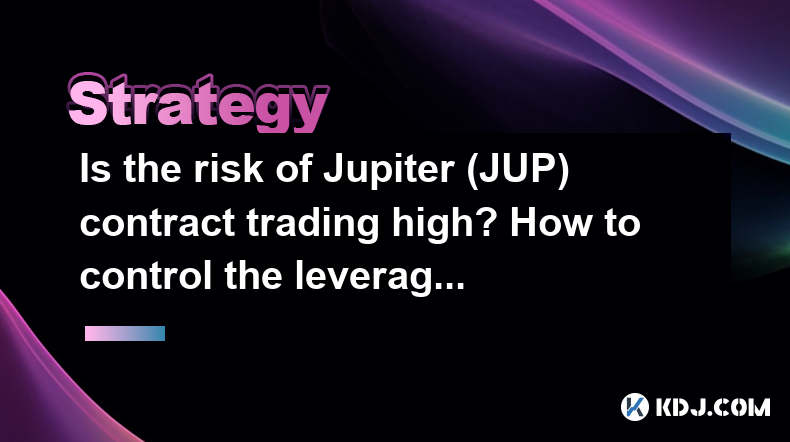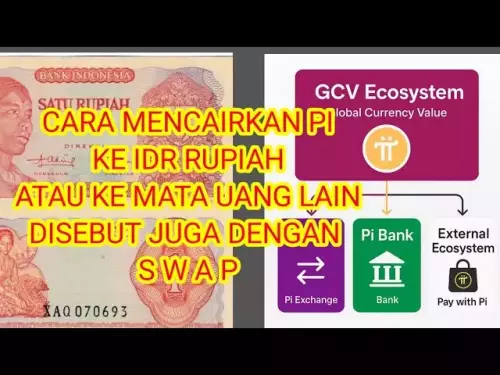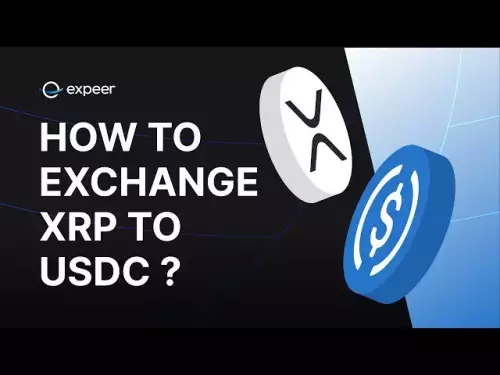-
 bitcoin
bitcoin $112715.707551 USD
-1.71% -
 ethereum
ethereum $4101.475385 USD
-3.01% -
 tether
tether $1.000644 USD
-0.02% -
 bnb
bnb $1207.619465 USD
-6.77% -
 xrp
xrp $2.501451 USD
-3.98% -
 solana
solana $202.947124 USD
-3.32% -
 usd-coin
usd-coin $1.000295 USD
0.04% -
 dogecoin
dogecoin $0.203884 USD
-4.47% -
 tron
tron $0.317154 USD
-1.72% -
 cardano
cardano $0.695009 USD
-4.43% -
 hyperliquid
hyperliquid $38.853961 USD
-8.23% -
 chainlink
chainlink $18.988674 USD
-4.64% -
 ethena-usde
ethena-usde $1.000233 USD
-0.03% -
 stellar
stellar $0.337050 USD
-3.63% -
 bitcoin-cash
bitcoin-cash $536.861728 USD
-1.28%
Is the risk of Jupiter (JUP) contract trading high? How to control the leverage ratio?
Trading Jupiter (JUP) contracts is high risk due to crypto volatility and leverage; control leverage by choosing lower ratios, setting stop-losses, and monitoring margins.
Apr 30, 2025 at 04:07 pm

Is the risk of Jupiter (JUP) contract trading high? How to control the leverage ratio?
Trading Jupiter (JUP) contracts can indeed be high risk, primarily due to the inherent volatility of cryptocurrencies and the use of leverage in contract trading. Leverage can amplify both gains and losses, making it crucial for traders to understand and manage their exposure effectively. In this article, we will delve into the risks associated with Jupiter (JUP) contract trading and provide detailed guidance on how to control the leverage ratio to mitigate those risks.
Understanding the Risks of Jupiter (JUP) Contract Trading
Jupiter (JUP) contract trading involves betting on the future price movement of the JUP token without actually owning it. The primary risk comes from market volatility, which can cause significant price swings in a short period. This volatility, combined with the use of leverage, can lead to substantial losses if the market moves against the trader's position.
Another risk factor is liquidation. When trading with leverage, if the market moves against your position, you may face a margin call, where you must either add more funds to your account or face liquidation. Liquidation occurs when the value of your position falls below a certain threshold, and the exchange closes your position to prevent further losses.
Lastly, lack of experience and knowledge can exacerbate these risks. Traders who are new to cryptocurrency or contract trading might not fully understand the mechanics of leverage and margin, leading to poor decision-making and increased risk exposure.
How to Control the Leverage Ratio in Jupiter (JUP) Contract Trading
Controlling the leverage ratio is essential for managing risk in Jupiter (JUP) contract trading. Here are detailed steps to help you control your leverage ratio effectively:
Understand the concept of leverage: Leverage allows you to control a larger position with a smaller amount of capital. For example, if you use 10x leverage, you can control a position worth 10 times your initial investment. However, this also means that a 10% move against your position can result in a total loss of your initial investment.
Choose the right leverage level: Most trading platforms offer a range of leverage options, from 1x to 100x or more. Start with lower leverage if you are new to trading or unsure about the market. A lower leverage ratio reduces the risk of liquidation and gives you more room to maneuver.
Set a maximum leverage limit: Decide on a maximum leverage ratio that you are comfortable with and stick to it. This helps prevent impulsive decisions to increase leverage during market volatility.
Use stop-loss orders: A stop-loss order can automatically close your position if the market moves against you by a certain amount. Setting a stop-loss helps limit potential losses and is crucial when trading with leverage.
Monitor your margin level: Keep an eye on your margin level, which is the ratio of your account equity to the total value of your open positions. If your margin level falls below the maintenance margin requirement, you risk liquidation. Regularly check your margin level and be prepared to add more funds if necessary.
Diversify your positions: Instead of putting all your capital into a single leveraged position, consider spreading it across multiple trades with different leverage ratios. Diversification can help mitigate risk by reducing the impact of a single adverse market move.
Tools and Platforms for Managing Leverage in Jupiter (JUP) Contract Trading
Several platforms offer tools to help you manage leverage effectively when trading Jupiter (JUP) contracts. Here are some popular options:
Binance Futures: Binance offers a wide range of leverage options and advanced tools for managing risk. You can set custom leverage ratios, use stop-loss orders, and monitor your margin level in real-time.
Bybit: Bybit provides a user-friendly interface and a variety of leverage options. The platform also offers features like isolated margin, which allows you to set a specific amount of margin for each position, helping you control your exposure.
FTX: FTX is known for its flexibility in leverage options and offers tools like cross-margin and isolated margin trading. You can also use the platform's risk management features to set custom leverage limits and stop-loss orders.
Practical Example of Controlling Leverage in Jupiter (JUP) Contract Trading
Let's walk through a practical example of how to control leverage when trading Jupiter (JUP) contracts on Binance Futures:
Log in to your Binance account and navigate to the Futures trading section.
Select Jupiter (JUP) from the list of available contracts.
Choose your leverage level: For this example, let's start with 5x leverage. Click on the 'Leverage' button and select 5x from the dropdown menu.
Set your position size: Decide on the amount you want to invest. For instance, if you want to invest $100, with 5x leverage, you will control a position worth $500.
Set a stop-loss order: To limit potential losses, set a stop-loss order. For example, if you enter a long position at $1.00, you might set a stop-loss at $0.95 to limit your loss to 5%.
Monitor your margin level: Keep an eye on your margin level throughout the trade. If it starts to approach the maintenance margin level, be prepared to add more funds or close the position.
Adjust leverage if necessary: If the market becomes more volatile, you might decide to reduce your leverage to 3x or 2x to decrease your risk exposure.
Strategies for Reducing Risk in Jupiter (JUP) Contract Trading
In addition to controlling leverage, there are several strategies you can use to reduce risk when trading Jupiter (JUP) contracts:
Conduct thorough research: Before entering a trade, analyze the market trends, news, and technical indicators related to Jupiter (JUP). Understanding the factors that can influence the price can help you make more informed trading decisions.
Use risk management tools: Most trading platforms offer risk management tools like take-profit and stop-loss orders. Utilize these tools to automatically close your positions at predetermined levels, helping you lock in profits and limit losses.
Start with a demo account: If you are new to contract trading, consider starting with a demo account. Practicing with virtual funds can help you gain experience and confidence without risking real money.
Keep emotions in check: Emotional trading can lead to impulsive decisions and increased risk. Develop a trading plan and stick to it, regardless of short-term market fluctuations.
Regularly review your performance: Keep track of your trades and analyze your performance over time. Identify patterns in your trading behavior that may be leading to losses and adjust your strategy accordingly.
Frequently Asked Questions
Q: Can I change the leverage ratio during an open position?A: Yes, most trading platforms allow you to adjust the leverage ratio of an open position. However, be aware that changing leverage can affect your margin level and potentially trigger a margin call if not managed properly.
Q: What is the difference between isolated and cross margin trading?A: In isolated margin trading, you allocate a specific amount of margin to each position, which limits your risk to that amount. In cross margin trading, your entire account balance is used as margin for all positions, which can help prevent liquidation but increases overall risk exposure.
Q: How often should I monitor my Jupiter (JUP) contract positions?A: It is advisable to monitor your positions regularly, especially during periods of high market volatility. Depending on your trading strategy, you might check your positions multiple times a day or set alerts to notify you of significant price movements.
Q: Is it possible to trade Jupiter (JUP) contracts without leverage?A: Yes, you can trade Jupiter (JUP) contracts without leverage by using 1x leverage. This approach reduces the risk of liquidation but also limits potential gains compared to trading with higher leverage.
Disclaimer:info@kdj.com
The information provided is not trading advice. kdj.com does not assume any responsibility for any investments made based on the information provided in this article. Cryptocurrencies are highly volatile and it is highly recommended that you invest with caution after thorough research!
If you believe that the content used on this website infringes your copyright, please contact us immediately (info@kdj.com) and we will delete it promptly.
- Tokenization Takes Center Stage: SEC-Registered Stock Tokens Reshape Finance
- 2025-10-15 22:25:13
- Bitcoin Seized, Transferred: A New York Minute on Crypto's Wild Ride
- 2025-10-15 22:25:13
- Milk & Mocha's $HUGS: Can This Crypto Presale Deliver a 100x Portfolio?
- 2025-10-15 22:30:01
- Memecoins Grow Up: $HUGS Presale Offers Real Utility
- 2025-10-15 22:45:13
- HUGS Launch, Crypto Bull Run, and a Perfect Storm Brewing?
- 2025-10-15 22:45:13
- Zero Knowledge Proof, Whitelists, and the Future of Blockchain Privacy
- 2025-10-15 22:30:01
Related knowledge

Practical parameter settings for a Bitcoin multi-timeframe moving average system
Sep 18,2025 at 10:54pm
Optimizing Timeframe Combinations for Bitcoin Trading1. Selecting appropriate timeframes is crucial when building a multi-timeframe moving average sys...

How can I filter out false breakouts in Dogecoin high-frequency trading?
Sep 22,2025 at 01:00am
Understanding False Breakouts in Dogecoin Trading1. A false breakout occurs when Dogecoin's price appears to move beyond a defined support or resistan...

Techniques for identifying tops and bottoms in the Bitcoin on-chain NVT model
Sep 20,2025 at 07:54pm
Understanding the NVT Model in Bitcoin Analysis1. The Network Value to Transactions (NVT) ratio is often described as the 'P/E ratio' of the cryptocur...

What does the surge in open interest in Bitcoincoin futures mean?
Sep 20,2025 at 11:18pm
Understanding the Surge in Dogecoin Futures Open Interest1. A surge in open interest within Dogecoin futures indicates a growing number of active cont...

How can I use the Ethereum USDT premium to gauge market sentiment?
Sep 18,2025 at 11:55pm
Understanding the Ethereum USDT Premium1. The Ethereum USDT premium refers to the price difference between USDT (Tether) traded on Ethereum-based plat...

What should I do if Ethereum staking yields decline?
Sep 20,2025 at 06:18am
Understanding the Causes Behind Declining Ethereum Staking Yields1. The Ethereum network transitioned to a proof-of-stake consensus mechanism with the...

Practical parameter settings for a Bitcoin multi-timeframe moving average system
Sep 18,2025 at 10:54pm
Optimizing Timeframe Combinations for Bitcoin Trading1. Selecting appropriate timeframes is crucial when building a multi-timeframe moving average sys...

How can I filter out false breakouts in Dogecoin high-frequency trading?
Sep 22,2025 at 01:00am
Understanding False Breakouts in Dogecoin Trading1. A false breakout occurs when Dogecoin's price appears to move beyond a defined support or resistan...

Techniques for identifying tops and bottoms in the Bitcoin on-chain NVT model
Sep 20,2025 at 07:54pm
Understanding the NVT Model in Bitcoin Analysis1. The Network Value to Transactions (NVT) ratio is often described as the 'P/E ratio' of the cryptocur...

What does the surge in open interest in Bitcoincoin futures mean?
Sep 20,2025 at 11:18pm
Understanding the Surge in Dogecoin Futures Open Interest1. A surge in open interest within Dogecoin futures indicates a growing number of active cont...

How can I use the Ethereum USDT premium to gauge market sentiment?
Sep 18,2025 at 11:55pm
Understanding the Ethereum USDT Premium1. The Ethereum USDT premium refers to the price difference between USDT (Tether) traded on Ethereum-based plat...

What should I do if Ethereum staking yields decline?
Sep 20,2025 at 06:18am
Understanding the Causes Behind Declining Ethereum Staking Yields1. The Ethereum network transitioned to a proof-of-stake consensus mechanism with the...
See all articles










































































